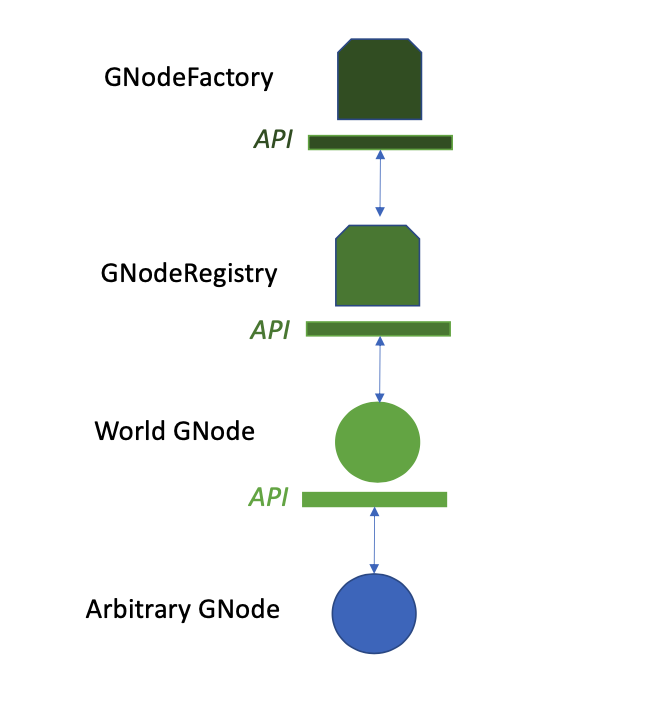GNodeFactory
The GNodeFactory is responsible for the topology of the GNodeTree - and importantly its copper sub-tree. It also managing the process of creating and updating Algorand certificates (TaDeeds, TaTradingRights, DiscoveryCertificates). This provides the foundation for scalable, decentralized verification of the bijection between online avatars and their real-life partners (e.g. TerminalAssets <-> Transactive Device). This validation process uses the Algorand blockchain.
There are several layers of indirection between an arbitrary GNode and the GNodeFactory.
A unique World GNode sitting at the top of a World’s GNodeTree and – for its descendants – acts as the Single Source of Truth (SSoT) for updates related to the GNodeTree and associated data. Under the hood, the World GNode’s actor is responsible for managing the applications representing the GNodes in that World (captured by the concept of GNodeInstance).

The GNodeFactory also manages WorldInstances. This allows for multiple simulations to run that share the same GNodeTree. Scenarios where actual money changes hands (e.g., using the Algorand Mainnet instead of TestNet or sandbox) occur in the production universe. To prevent the obvious potential issue of double-counting, there is only one WorldInstance in the production universe.
Although the GNodeFactory spawns WorldInstances, a World’s GNode actor does not directly communicate with the GNodeFactory. This is because the GNodeFactory does not track all of the relevant information about GNodes. For example, detailed information about a GNode’s associated Physical Device is not managed by the GNodeFactory.
In order to get its information about a specific GNode, therefore, the World GNode actor communicates with the GNodeRegistry for that GNode. The GNodeRegistry is the authority for certain kinds of information that the GNodeFactory does not track. Under the hood, that GNodeRegistry communicates with the (unique) GNodeFactory in that universe for key topological and identity information.
The open-souce repository for the GNodeFactory can be found here.
GNfAdminAddr
GnfAdminAddr is the primary Algorand address associated to the GNodeFactory. This address is used in numerous validation checks for GridWorks types. It is available as an environment variable.
from gridworks.gw_config import Public
gnf_admin_addr = Public().gnf_admin_addr
assert gnf_admin_addr == "RNMHG32VTIHTC7W3LZOEPTDGREL5IQGK46HKD3KBLZHYQUCAKLMT4G5ALI"
Note that the GNodeFactory is designed to be unique. However, as a developer, you can run GridWorks simulations on your laptop, with no Internet. GridWorks has the concept of Universe, which can be Dev, Hybrid or Production. Each of these has a unique GnfAdminAddr.
TaValidatorFundingThresholdAlgos
In order to be certified as a TaValidator, an entity must put enough skin in the game to show that they are serious about doing TerminalAsset validations. They are required to fund their 2-sig Multi [GnfAdminAddr, TaValidatorAddr] with this amount. In the Dev Universe, this is set to 100 Algos.
from gridworks.gw_config import Public
threshold = Public().ta_validator_funding_threshold_algos
assert threshold == 100
TaDeedConsiderationAlgos
A TaOwner must fund their TaDaemonAddr with an initial consideration in order to receive their initial TaDeed and TaTradingRights (or more accurately, for the TaDaemonAddr to receive these). This account will be actively involved in transactions with an AtomicTNode as the AtomicTNode transacts on behalf of the TerminalAsset in markets. Prior to entering into markets, initial requirements may be made about the funding level of the TaDaemonAddr - roughly equivalent to the energy costs incurred by a month of trading activity.
In the Dev Universe, the TaDeedConsiderationAlgos is set to 50 Algos.
from gridworks.gw_config import Public
threshold = Public().ta_deed_consideration_algos
assert threshold == 50
Back to Lexicon